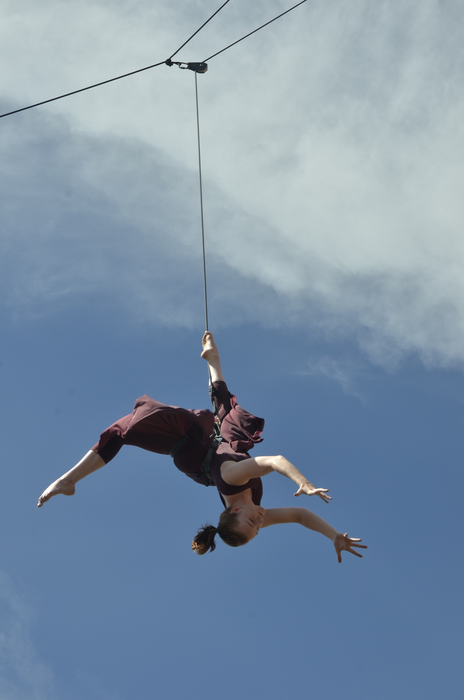Previous studies have determined that astronauts can judge inverted movements better than people on Earth due to the astronauts’ unique visuomotor experience with inverted movements in space.

Credit: University of Wyoming
Previous studies have determined that astronauts can judge inverted movements better than people on Earth due to the astronauts’ unique visuomotor experience with inverted movements in space.
Now, a new study, in which University of Wyoming researchers played key lead roles, shows that people on Earth with extended visuomotor experience with inverted movements — such as vertical dancers — can overcome the inversion effect in perceiving biological motion.
Qin Zhu, a UW professor of kinesiology and health, was lead and senior author of a paper titled “Extended Visuomotor Experience With Inverted Movements Can Overcome the Inversions of Effect in Biological Motion Perception” that was published Oct. 20 in Scientific Reports, an online peer-reviewed, open-access journal that covers all areas of the natural sciences.
“As indicated by the title of the article, we proved that the inversion effect in biological motion perception (BMP) can be overcome,” Zhu says. “BMP is intriguing because it is a survival skill humans and animals both share. We can read the motions produced by others in same or different species and figure out who the actor is and what is intended by the actor. So, we can better prepare our response, either to escape or engage. However, if the motion is performed upside-down, or inverted, such a capability will be greatly impaired.”
Margaret Wilson, professor and head of the UW Department of Theatre and Dance, was second author of the paper. For the study, Wilson provided the list of vertical dance movements; facilitated motion-capture of the movements; recruited vertical dancers for the experiment; and revised the paper.
Xiaoye Wang, a postdoctoral fellow in the Department of Kinesiology and Physical Education at the University of Toronto, was another lead author of the paper. Zhu worked with Wang to conceptualize and implement the study; analyze results; and draft and revise the paper.
Other contributors were from Shanghai University of Sport and Shanghai University of Finance and Economics, who helped recruit participants in China to help increase the diversity of sample sizes of the study.
The study was composed of 52 adult volunteers — 15 participants without any dance experience; 21 participants with an average of 7.71 years of typical dance experience; and 16 participants with 4.75 years of vertical dance experience. The vertical dancers were from UW and Europe.
Subjects were presented 40 dance movements as point-light displays on a computer. There were 10 pairs of dance movements, with each pair including a dance movement performed on the ground and another performed in the air. In half of the test trials, the display was artificially inverted. Vertical dancers, traditional dancers and non-dancers were asked whether the display was artificially inverted or as it was.
Only vertical dancers could identify the inversion movements performed in the air. Vertical dancers were equally capable of identifying an artificial inversion regardless of whether the dance movement was performed on the ground or in the air.
Traditional dancers and non-dancers — who had no experience with performing inverted movement — could not distinguish the inversion on the point-light display for the inverted movements performed in the air, according to the paper. The paper’s findings suggest that visuomotor experience with inverted movements plays a more critical role in allowing observers to identify in the inverted biological motion.
Zhu says those with experience viewing and/or performing inverted movements while suspended in the air can use that experience to perceive and understand the inverted movements.
“Therefore, spectators who have seen vertical dance performances before will have a better understanding of inverted movements than those who have never seen such a performance,” Zhu says. “And, for those who want to learn and perform vertical dance in the future, both visual and motor training — with respect to the inverted movements — are required to improve awareness and perception of self-movements in relation to partners or spectators while performing vertical dance.”
Zhu adds that people without any dance experience can judge the upright dance movements “pretty well” compared to trained dancers, which suggests that there are similarities between upright dance movements and movements in daily life.
“Relating to science fiction, Spiderman should have a superior ability over others to read any inverted movements,” Zhu says.
A follow-up study, using an eye tracker, has been performed to examine the visual search patterns of vertical dancers versus traditional dancers while each group observes the point-light displays to judge the actions.
“Based on the research findings, a visual training program will be designed to train students who are enrolled in UW vertical dance classes,” Zhu says.
Journal
Scientific Reports
DOI
10.1038/s41598-022-21000-1
Method of Research
Experimental study
Subject of Research
People
Article Publication Date
20-Oct-2022




